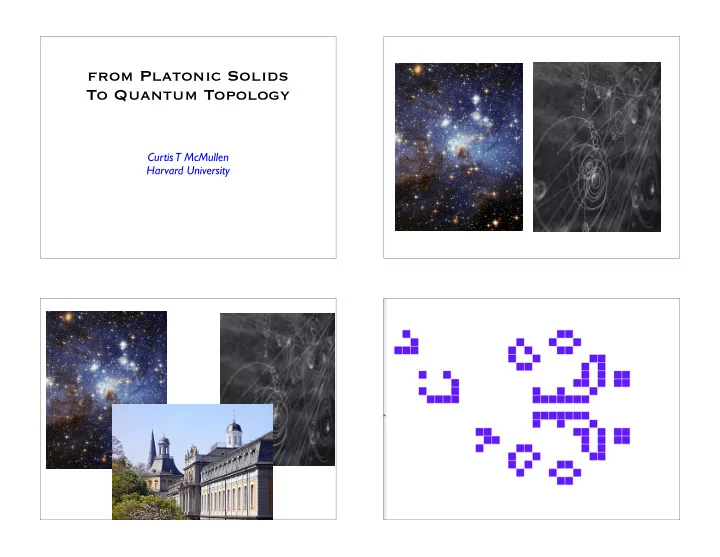

from Platonic Solids To Quantum Topology Curtis T McMullen Harvard University
Kepler Plato 1596 360 BC De revolutionibus orbium coelestium --Copernicus, 1543 E pur si muove --Galileo, 1633
Klein, 1879 (2,3,5) (2,3,6) (2,3,7) Dynamical solution of quintics Buckminsterfullerene C 60 PSL 2 (Z/7) PSL 2 (Z/5) Kroto Curler Smalley 1985 order 168 order 60 Braids Genus 3 { } Braid group Polynomials p(x) of degree n Helaman Ferguson, 1993 P n = B n = � 1 (P n ) with distinct roots 168 = 7x24 = |PSL 2 (Z/7)|
Hodge theory n=3: Triangle groups X X Polynomial ⇒ Riemann surface Polynomial ⇒ Riemann surface � Z/d = 〈 T 〉 � Z/d X : y d = x(x-1)(x-t) X : y d = (x-b 1 ) ... (x-b n ) P 1 P 1 � q : B 3 � U(2) or U(1,1) q = -e(-1/p) ⇒ complex cohomology group H 1 (X) intersection form ⇒ eigenspace Ker(T -qI) = H 1 (X) q (r,s) q d =1 ⇒ rep � q : B n = � 1 (P n ) � U(H 1 (X) q ) U(r,s) { CP r − 1 ] [ 4 positive lines 5 6 p=3 ⇒ period map f q : T * 0,n � = CH s in H 1 (X) q 7 ... q ... 1 [p(x)] � [dx/y k ] q = e(-k/d) Classical Platonic [finite] case: n=3: Period map = Riemann map Integral miracles (Schwarz) � q (B 4 ) � U(3) finite � /p �� 1 � 4 f dx = � ( x ( x − 1)( x − a )( x − b )) 3 / 4 0 � /p � /p 0 1 � � π 2 Γ (1 / 4) 4 ((2 a − 1) b ( b − 1) + (2 b − 1) a ( a − 1)) 4 · Γ (3 / 4) 4 � � 1 a 2 b 2 ( a − 1) 2 ( b − 1) 2 ( a + b − 2 ab − 2 ab ( a − 1)( b − 1)) 3 �� ∞ dx dx f ( t ) = y k y k 0 1 Note: upon changing 3/4 to 1/2, we obtain an elliptic modular function (transcendental). y d = x ( x − 1)( x − t )
Complex Hyperbolic Case Theorem � q (B n ) � U(1,s) � Isom( CH s ) Theorem (Deligne-Mostow, Thurston) The Platonic solids and their generalizations are moduli spaces of points configurations on P 1 , M 0,n is a complex hyperbolic manifold for made geometric using Hodge theory. n=4,5,6,8,12. 3 3 • Hypersurfaces of low degree in P 2, P 3 , P 4 , and P 1 xP 1 have been similarly investigated by branched covers/Hodge theory (Allcock, Carlson, Toledo, Kondo, Dolgachev, Looijenga, ...) � p 2 2 M 0,4 M 0,4 Positively Curved 3-Manifolds Negatively Curved 3-Manifolds
Tilings, Groups, Manifolds Arithmetic Examples � in SL 2 (R) = Isom(H 2 ) � = SL 2 (Z[ � ]) SL 2 (Z) SL 2 (Z[i]) H 2 / � = surface H 2 / Γ = S 2 \ K � in SL 2 (C) = Isom(H 3 ) ? H 3 / � = 3-manifold H 3 / Γ = S 3 \ K Mostow: Topology ⇒ Geometry Knots with 10 crossings
Hyperbolic volume The Perko Pair as a topological invariant K = � π / 3 vol( S 3 − 1 K ) = 6 ( π / 3) = 6 log 2 sin θ d θ 0 = 2.0298832128193... Towards the Poincaré Conjecture? Thurston’s theorem 1980s M 3 -K M 3 -K M 3 =S 3 angle small angle 180 angle 360 Almost all knot complements are hyperbolic. Hoste, Thistlethwaite and Weeks, 1998 : The First 1,701,936 knots (Up to 16 crossings)
Perelman’s proof Theorem: General relativity places no constraints on the topology of the Universe. Quantum permutations + knots Representations of braid groups B 1 1 B 2 1 1 B 3 2 1 B 4 2 3 1 B 5 5 4 1 B 6 5 9 5 1 permutation a a a b a -1 b � = B 7 14 14 6 1 (123)
The Jones polynomial Jones polynomial for figure 8 knot For K = the closure of � in B n: V(t) = t -2 -t -1 +1-t+t 2 V(K,t) = (-t 1/2 - t -1/2 ) n-1 t deg( � ) Tr( � ) skein theory t -1 V + - tV - = (t 1/2 - t -1/2 ) V 0 V(O,t) = 1 Volume Conjecture Quantum fields (Witten) Murakami-Murakami Kashaev � K � = � Tr( � A) e 2 � ik CS(A) DA n/ 2 � n − j � � ( − 1) j V ( K n − 2 j , t ) V n +1 ( K, t ) = K j j =0 Cable K 2 for figure = (q 1/2 +q -1/2 ) V(K,1/q) eight knot K 2 � log |V n (K,e 2 � i/n )| hyperbolic q = exp(2 � i/(2+k)) � 1 as k � � � vol(S 3 -K) n � unknot � � 2 quantum fields general relativity
Challenge: Find the geometry of a 3-manifold using quantum topology
Recommend
More recommend